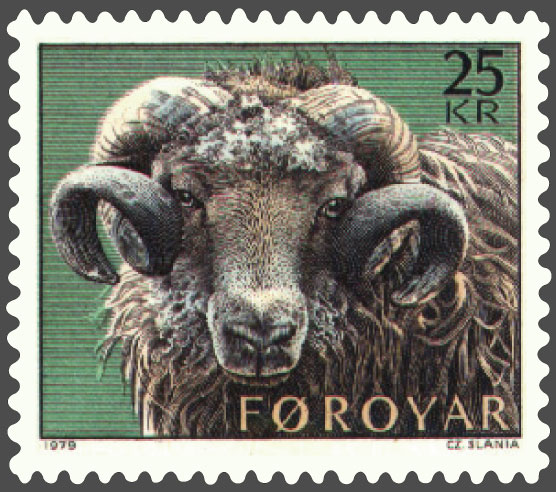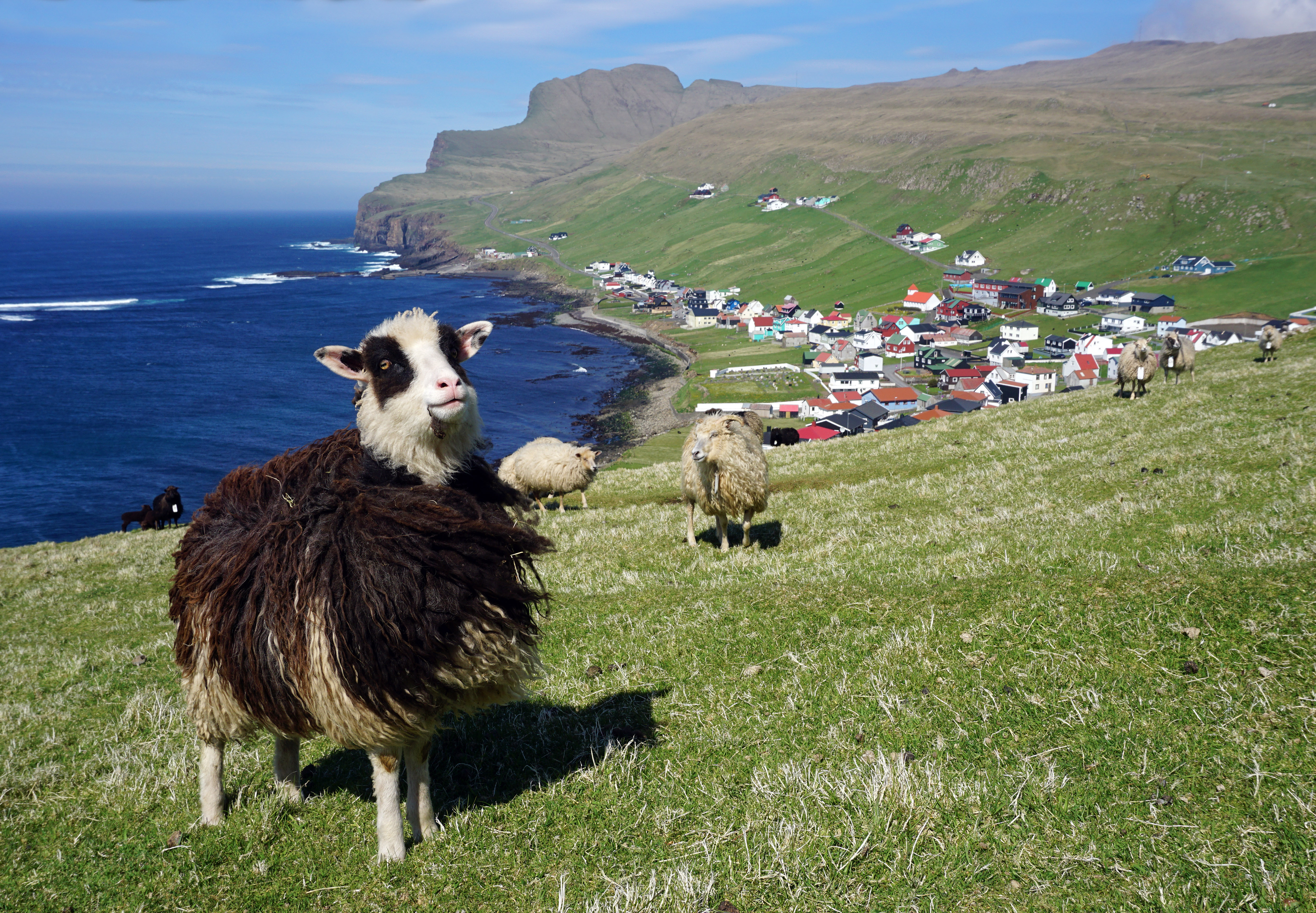Faroes (sheep) on:
[Wikipedia]
[Google]
[Amazon]
The Faroese sheep ( fo, Fû¡royskur seyû¯ur) is a breed of 

Bû¤naû¯arstovan
(Office for Agriculture) has calculated that locally produced mutton and lamb has an estimated value of 35 million Dkk yearly.
sheep
Sheep or domestic sheep (''Ovis aries'') are domesticated, ruminant mammals typically kept as livestock. Although the term ''sheep'' can apply to other species in the genus '' Ovis'', in everyday usage it almost always refers to domesticate ...
native to the Faroe Islands
The Faroe Islands ( ), or simply the Faroes ( fo, Fû¡royar ; da, FûÎrû¡erne ), are a North Atlantic island group and an autonomous territory of the Kingdom of Denmark.
They are located north-northwest of Scotland, and about halfway bet ...
.
First introduced in the 9th century, Faroese sheep have long been an integral part of the island traditions: The name ''"''Faroe Islands" has been argued to ultimately derive from ''fûÎr,'' the word for sheep in Old Norse
Old Norse, Old Nordic, or Old Scandinavian, is a stage of development of North Germanic dialects before their final divergence into separate Nordic languages. Old Norse was spoken by inhabitants of Scandinavia and their overseas settlement ...
, and the animal is depicted on the country's coat of arms
A coat of arms is a heraldic visual design on an escutcheon (i.e., shield), surcoat, or tabard (the latter two being outer garments). The coat of arms on an escutcheon forms the central element of the full heraldic achievement, which in its ...
. One of the Northern European short-tailed sheep
The Northern European short-tailed sheep are a group of traditional sheep breeds or types found in Northern Europe, mainly in the British Isles, Scandinavia, Greenland and the area around the Baltic. They are thought to be derived from the fi ...
, it is a small, very hardy breed. Faroes ewes weigh around at maturity, and rams are . Rams are horned
A horn is a permanent pointed projection on the head of various animals that consists of a covering of keratin and other proteins surrounding a core of live bone. Horns are distinct from antlers, which are not permanent.
In mammals, true ho ...
and ewes are usually polled, and the breed occurs naturally in many different colours, with at least 300 different combinations, each of which has its own unique name.
Faroese sheep tend to have very little flocking instinct due to no natural predators, and will range freely year round in small groups in pastureland, which ranges from meadow
A meadow ( ) is an open habitat, or field, vegetated by grasses, herbs, and other non- woody plants. Trees or shrubs may sparsely populate meadows, as long as these areas maintain an open character. Meadows may be naturally occurring or arti ...
s, to rugged rocky mountaintops and lush bird-cliffs. They are most closely related to the Norwegian SpûÎlsau and Icelandic sheep
The Icelandic is the Icelandic breed of domestic sheep. It belongs to the Northern European Short-tailed group of sheep, and is larger than most breeds in that group. It is thought that it was introduced to Iceland by Vikings in the late nint ...
.
Ears are usually cut with various simple designs, to denote ownership and what pastures the sheep belong on. There are 54 different official cuts, which can be paired in a vast variety of ways; it is not permitted to use the same combination twice on the same island. The first known law regarding earmarks is in the Sheep letter from 1298, where it is stated among other things in the fifth section:
The agricultural policies of the Faroe Islands, have over the centuries divided the pasture
Pasture (from the Latin ''pastus'', past participle of ''pascere'', "to feed") is land used for grazing. Pasture lands in the narrow sense are enclosed tracts of farmland, grazed by domesticated livestock, such as horses, cattle, sheep, or sw ...
into 463 different land lot
In real estate, a lot or plot is a tract or parcel of land owned or meant to be owned by some owner(s). A plot is essentially considered a parcel of real property in some countries or immovable property (meaning practically the same thing) in o ...
s, with a value measured in mark, and between 40 and 48 ewes going on each mark has resulted in the total prescribed number of ewes that the land can support, being 70.384.
During the late 19th and early 20th centuries, Scottish sheep were imported, mostly in order to produce better wool. This has resulted in some Faroese sheep being of a mixed breed; the majority are still pure.


Economic value and traditional usage
Traditionally, wool and wool products have been the leading economic factor for the Faroese households. A considerable number of knitted sweaters were exported with standing orders to theDanish army
The Royal Danish Army ( da, HûÎren, fo, Herurin, kl, Sakkutuut) is the land-based branch of the Danish Defence, together with the Danish Home Guard. For the last decade, the Royal Danish Army has undergone a massive transformation of structur ...
, specially during the Napoleonic wars
The Napoleonic Wars (1803ã1815) were a series of major global conflicts pitting the French Empire and its allies, led by Napoleon I, against a fluctuating array of European states formed into various coalitions. It produced a period of Fre ...
, when several thousand sweaters were exported yearly. Wool socks, and measures of wadmal were used during the 1600s as some of various products taxes were permitted to be payable with. The Royal Danish monopoly received 100,000 home made sweaters and 14,000 pairs of socks in 1849, at a time when only 8,000 people lived on the archipelago. Storting
The Storting ( no, Stortinget ) (lit. the Great Thing) is the supreme legislature of Norway, established in 1814 by the Constitution of Norway. It is located in Oslo. The unicameral parliament has 169 members and is elected every four years ...
et (The Norwegian parliament) in Norway
Norway, officially the Kingdom of Norway, is a Nordic countries, Nordic country in Northern Europe, the mainland territory of which comprises the western and northernmost portion of the Scandinavian Peninsula. The remote Arctic island of ...
made a decree in 1898 that all Norwegian infantry should wear Faroese sweaters under their uniforms in winter time. The meat would be consumed locally over the winter. "Ull er Fû¡roya gull", meaning "wool is Faroese gold", is a saying which hails from this time and is sometimes heard in modern times when it is lamented how little value the wool has today.
The wool is still used but at a much reduced rate compared to its historic use, with much of the wool being burnt, or in some cases sheep are left unsheared to molt naturally on their own; this is however frowned upon by many. There are a few spinning companies around the islands producing yarn
Yarn is a long continuous length of interlocked fibres, used in sewing, crocheting, knitting, weaving, embroidery, ropemaking, and the production of textiles. Thread is a type of yarn intended for sewing by hand or machine. Modern manu ...
, mostly for domestic use and for the tourist industry
Tourism is travel for pleasure or business; also the theory and practice of touring, the business of attracting, accommodating, and entertaining tourists, and the business of operating tours. The World Tourism Organization defines tourism mor ...
. Sweaters, sock
A sock is a piece of clothing worn on the feet and often covering the ankle or some part of the calf. Some types of shoes or boots are typically worn over socks. In ancient times, socks were made from leather or matted animal hair. In the la ...
s and shawls are the most popular items. There have been some attempts to kick start a fashion industry based on Faroese wool, with Guû¯run & Guû¯run being the most successful.
The time of year the sheep will start shedding their wool, is heavily determined by the weather. A good warm spring, with good growth may trigger the shedding as early as late May, whereas a long cold and wet spring and summer, might not trigger the shedding until late July or in a few instances early August. If the sheep are gathered for shearing at a prime moment, then the fleece will easily part from the body by only sliding a hand betwixt the old and new fleece layers. The shorn fleece consists of two layers, the inner layer being fine, lanolin rich wool, perfect for underwear and other fine garments. The outer layer made up of coarse long hairs, traditionally used for heavy duty clothing, such as thick sweaters for fishermen, or even some early arctic explorers.
Today, the breed is mainly kept for its meat, with a wide variety of local dishes being favoured heavily over foreign inspired culinary art. Skerpikjû¡t
Skerpikjû¡t, a type of wind-dried mutton, is a delicacy of the Faroe Islands.Jû ...
, air dried meat; and rûÎst kjû¡t, meat which has dried and has become fermented, are the most popular, with fresh meat valued somewhat lessBû¤naû¯arstovan
(Office for Agriculture) has calculated that locally produced mutton and lamb has an estimated value of 35 million Dkk yearly.
Offal
Offal (), also called variety meats, pluck or organ meats, is the organs of a butchered animal. The word does not refer to a particular list of edible organs, which varies by culture and region, but usually excludes muscle. Offal may also refe ...
is still consumed by many, but it has been considerably losing support among the younger generations in recent years.
Every autumn, Bû¤naû¯arstovan(Office for Agriculture) has showings where rams and young potential breeding males are on show. These take place out in the various districts and villages.
See also
* Faroe Islands domestic animals * List of sheep breeds * LûÙtla DûÙmun sheepReferences
{{Commons category, Faroe sheep Sheep breedsSheep
Sheep or domestic sheep (''Ovis aries'') are domesticated, ruminant mammals typically kept as livestock. Although the term ''sheep'' can apply to other species in the genus '' Ovis'', in everyday usage it almost always refers to domesticate ...
Sheep breeds originating in Denmark